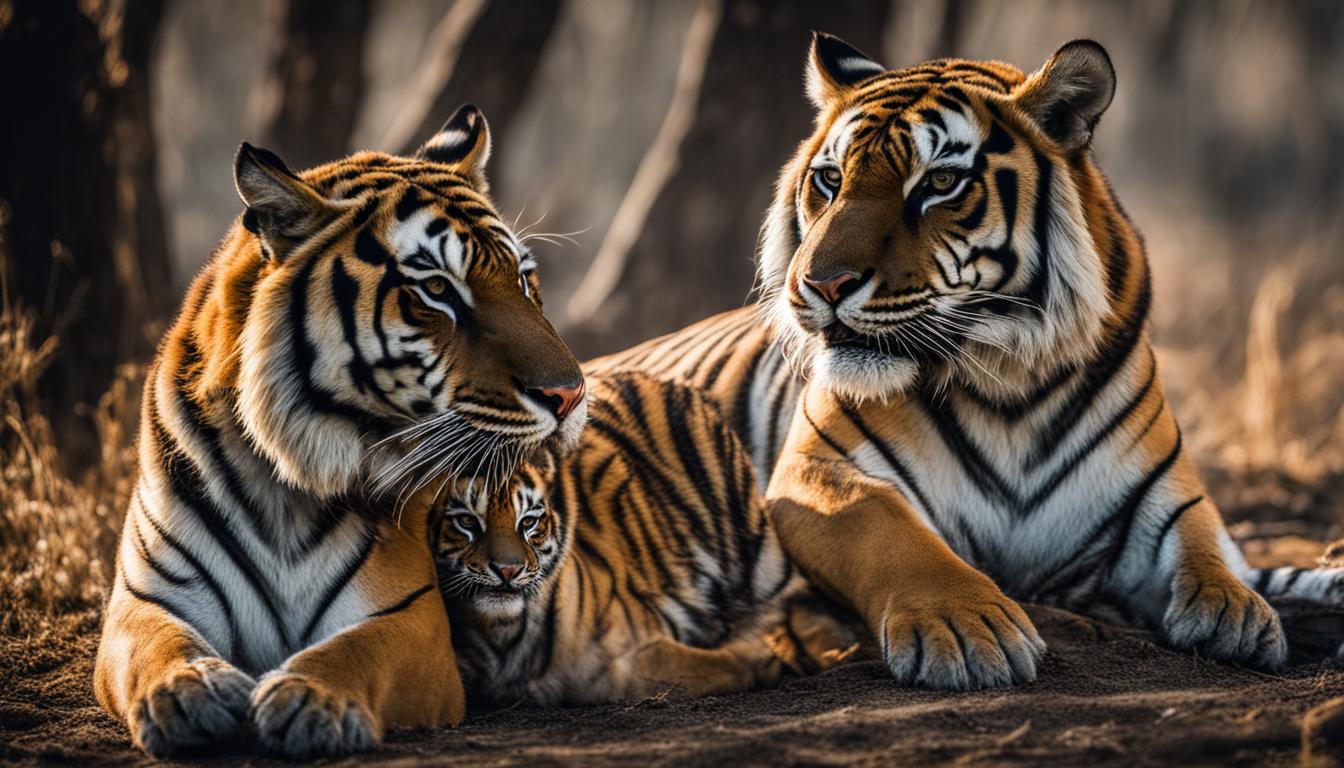Tigers, with their majestic presence and remarkable hunting skills, have a unique and fascinating reproduction cycle. If you’ve ever wondered about the mating behaviors, breeding strategies, and reproductive cycles of these magnificent big cats, read on to discover the secrets of tiger reproduction.
Key Takeaways:
- Tigers have a diverse range of mating behaviors and courtship rituals.
- Tiger reproduction is influenced by factors such as geographic location and seasonal breeding patterns.
- The estrus cycle of tigers can vary, with females coming into heat every 25 days on average.
- Copulation induces ovulation in tigers, and gestation lasts for approximately 103-106 days.
- Tiger cubs are born blind and defenseless, with closed eyes and ears, and their mortality rate is relatively high.
Courtship and Reproduction Behavior of Tigers
Tigers engage in fascinating courtship behavior before mating, displaying unique and intricate rituals. Courtship is a vital part of the reproductive process, allowing tigers to establish and strengthen bonds between potential mates. During courtship, both male and female tigers engage in various behaviors, such as vocalizations, rubbing against each other, and rolling on the ground. These actions serve to communicate interest and readiness for mating.
Female tigers exhibit heightened signs of receptivity, including constant vocalizing, pacing, and rubbing against objects. Males, on the other hand, vocalize to attract females and seize the female’s neck during copulation. The mating process involves the male mounting the female from behind, grasping her neck to maintain control.
Tiger Reproductive Organs
Tigers possess unique reproductive organs that contribute to their intricate mating behaviors. The male tiger’s penis has structures resembling spikes, which can potentially cause discomfort to the female during copulation. These structures aid in inducing ovulation and increase the chances of successful fertilization.
Tiger reproduction strategies also vary, with males often mating with multiple females. This strategy increases the male’s chances of passing on his genetic material and ensures the survival of the species. Reproduction in tigers relies on both innate behaviors and physical adaptations, highlighting the complexity of their reproductive cycle.
“Courtship rituals play a crucial role in tiger reproduction, allowing potential mates to assess each other’s suitability and strengthen the bond necessary for successful mating.”
| Tiger Courtship and Reproduction Behavior | Tiger Reproductive Organs |
|---|---|
| – Vocalizations | – Male’s penis with spike-like structures |
| – Rubbing and rolling on the ground | – Inducing ovulation through copulation |
| – Female’s constant vocalizing, pacing, and rubbing | – Increased fertilization chances |
| – Male seizing the female’s neck during copulation | – Mating with multiple females |
Understanding the courtship and reproduction behavior of tigers is essential for wildlife conservation efforts. By studying their unique behaviors and reproductive strategies, researchers and conservationists can develop effective strategies to ensure the survival of these majestic creatures in their natural habitats.
Tiger Reproduction in the Wild
Tigers in the wild exhibit fascinating reproductive behaviors and cycles that ensure the continuation of the species. The breeding seasons of tigers vary depending on their geographic location. In tropical regions, tigers engage in polyestrous mating year-round, with peak breeding activity occurring between November and April. On the other hand, Amur tigers, also known as Siberian tigers, are seasonal breeders, with their peak breeding activity observed from April to June. These variations in breeding seasons highlight the adaptability of tigers to their respective environments.
The reproductive cycle of tigers in the wild is characterized by regular intervals of heat, also known as estrus cycles. The length of these cycles can range from 3 to 9 weeks, with females displaying receptivity for about 5 days on average. During this period, tigers engage in courtship behaviors, including vocalizations, rubbing, and rolling. Males seize the female’s neck during copulation, and both males and females vocalize with sounds such as moaning, growling, and hissing. These behaviors contribute to the successful reproduction of tigers in their natural habitats.
To better understand the reproductive habits of tigers in the wild, it is important to study their mating behaviors. Tigers are known to engage in multiple copulations during a female’s receptive period, and mating itself induces ovulation. This reproductive strategy ensures a higher chance of successful fertilization. By studying tiger reproduction in the wild, researchers gain valuable insights into the intricate dynamics between mating behaviors, reproductive cycles, and the survival of the species.
| Tiger Reproduction in the Wild | Estrus Cycle | Peak Breeding Activity |
|---|---|---|
| Tropical Regions | 3-9 weeks | November to April |
| Amur Tigers | 3-9 weeks | April to June |
Tiger Gestation and Birth
After successful mating, tigers go through a gestation period that lasts approximately 103-106 days. During this time, the mother tiger carries her cubs in her womb, providing them with the necessary nourishment and protection. It is a crucial stage in the reproductive cycle of tigers, as the development of the cubs takes place inside the mother’s body.
Once the gestation period is complete, the mother tiger gives birth to her cubs. The average litter size is 2-3 cubs, although it can range from 1 to 7. The birth usually takes place in hidden locations such as tall grass, brush, rock piles, or caves, providing a safe and secure environment for the newborns.
Tiger cubs are born blind and defenseless, with closed eyes and ears. They weigh around 1.7-3.5 pounds at birth. Over the first two weeks, their eyes and ears open, allowing them to become more aware of their surroundings. The cubs develop thick, woolly fur to protect them from the elements. Despite their initial vulnerability, tiger cubs grow and thrive under the watchful care of their mother.
| Tiger Gestation and Birth | Characteristics |
|---|---|
| Gestation Period | Approximately 103-106 days |
| Litter Size | Average: 2-3 cubs, Range: 1 to 7 cubs |
| Birth Weight | Around 1.7-3.5 pounds |
| Birth Environment | Hidden locations such as tall grass, brush, rock piles, or caves |
| Newborn Characteristics | Blind, closed eyes and ears; eyes and ears open within the first two weeks; develop thick, woolly fur |
Life Stages of Tigers
Tigers go through various life stages, each with its own unique characteristics and behaviors. Understanding these stages is essential for gaining insights into the development and behavior of these magnificent creatures.
Tiger Cubs: The Early Years
Tiger cubs are born blind and defenseless, weighing about 1.7-3.5 pounds. They rely on their mother for nourishment and protection during this vulnerable stage. Within the first two weeks, their eyes and ears open, and they begin to develop thick, woolly fur. By two to three months old, they start eating solid food and learn essential skills from their mother, such as hunting techniques.
Tiger Juveniles: The Road to Independence
As tiger cubs grow, they progress into the juvenile stage, typically between one and three years old. During this period, they become more independent and start venturing away from their mother. Juvenile tigers begin practicing their hunting skills, honing their agility and strength. They still have much to learn and rely on their instincts and observations to navigate their surroundings.
Tiger Adults: The Apex Predators
By three to four years old, female tigers reach sexual maturity, while males mature around four to five years old. Adult tigers exhibit the full range of characteristics that make them apex predators. They have powerful bodies, sharp claws, and large teeth, enabling them to hunt and take down prey efficiently. Adult tigers are solitary animals, except during breeding season, and establish their territories to ensure sufficient resources for survival.
| Life Stage | Characteristics |
|---|---|
| Tiger Cubs | – Born blind and defenseless – Depend on mother for nourishment and protection – Develop fur and open eyes and ears within the first two weeks |
| Tiger Juveniles | – Begin eating solid food and learning hunting skills – Start becoming independent and venturing away from mother – Observe and practice essential behaviors for survival |
| Tiger Adults | – Reach sexual maturity – Possess powerful bodies, sharp claws, and large teeth – Establish territories and hunt for survival |
Understanding the different life stages of tigers provides valuable insights into their development, behavior, and conservation needs. From the vulnerable cubs relying on their mother’s care to the independent juveniles learning to survive on their own, and eventually the powerful adult predators, each stage contributes to the intricate tapestry of tiger life.
Conclusion
Tiger reproduction plays a crucial role in sustaining the species and ensuring their survival. With fascinating mating behaviors and unique reproductive cycles, tigers captivate us with their complex reproductive process. From courtship rituals to repeated copulations, these majestic creatures exhibit a range of behaviors to attract mates and ensure successful reproduction.
Gestation and birth are critical stages in the tiger life cycle. Mothers provide care and protection to their cubs, giving birth in hidden locations and creating safe nests. Tiger cubs, born blind and defenseless, rely on their mother’s guidance to develop essential skills and become independent. They go through various milestones, such as opening their eyes and ears, developing thick fur, and learning to hunt.
Understanding tiger mating behavior and their life cycle is vital for their conservation. By studying their reproductive strategies and addressing challenges such as high cub mortality rates, we can contribute to the long-term survival of tigers in the wild. With our efforts, we can help preserve these magnificent creatures for future generations to admire and cherish.
FAQ
How do tigers mate?
Tigers mate through courtship rituals and repeated copulations. The male seizes the female’s neck and mounts from behind to initiate mating.
What is the reproductive cycle of tigers?
Tigers are polyestrous, meaning they can mate year-round in tropical regions. In temperate regions, there is peak breeding activity during the winter months.
What are some unique reproductive behaviors of tigers?
Tigers engage in courtship behavior before mating, involving vocalizations, rubbing, and rolling. Males vocalize and seize the female’s neck during copulation. Both male and female tigers exhibit various sounds during mating, such as moaning, growling, and hissing.
How do tigers reproduce in the wild?
Tigers in the wild exhibit natural reproductive behaviors and cycles. Breeding seasons vary by location, with tropical regions showing year-round mating and peak breeding from November to April. Amur tigers are seasonal breeders with peak breeding from April to June.
What is the gestation period and litter size of tigers?
The gestation period of tigers lasts approximately 103-106 days. The average litter size is 2-3 cubs, but it can range from 1 to 7.
What are the life stages of tigers?
Tigers go through various life stages, starting as infants, then progressing to subadults and finally becoming adults. Tiger cubs go through developmental milestones, such as the eruption of milk teeth and starting to eat solid food. They learn to hunt by imitating their mother’s hunting behavior and become independent between 17-24 months.











